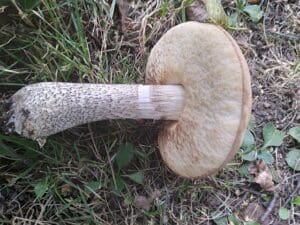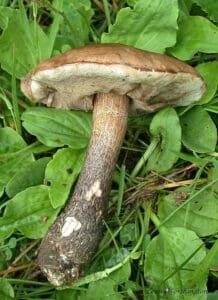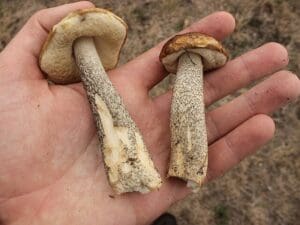Brown Birch Bolete / Summer / Autumn / Edible
The Brown Birch Bolete Mushroom is one we always stumble across when foraging in mixed woodlands that tend to contain some silver birch, from a distance you might think YES I have a Porcini, however when you get a little closer the first thing you see is that the stem is a longer and more dainty and then you see all of the other differences when closer again.
I’ll outline the other differences below for you too in this foragers’ guide to the Brown Birch Bolete
Scientific Name
Leccinum scabrum
Common names
Brown Birch Bolete, Birch bolete, rough-stemmed bolete
Family
Leccinium
Habitat
All Leccinum are ectomycorrhizal and most are specific to one tree species. The Brown Birch bolete only grows with Silver birch.
Very common in temperate areas of Europe, Asia and the Americas’ growing under silver birch trees. They prefer acidic soil, woodland edges and heathland
Summer to Autumn.
Description
A good fungi for beginners as it has no toxic look a likes. Find a birch woodland and you are bound to find the Brown Birch bolete, being taller than most other boletes they are a little easier to spot too. The Brown Birch bolete has no red and no blue
Why not check out ouor Brown Birch bolete foraging guide?
Identifying Features:
Cap:
5-15 cm starting ovate and becoming convex in various shades of brown occasionally with slight pinky or grey tinges. Looking very reminiscent of a well baked uneven bread roll as do many bolete. Sticky when wet.
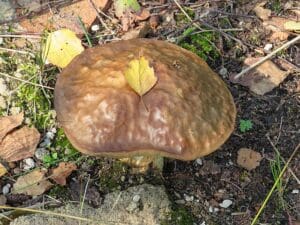
Stem:
The stem (stipe) looks ironically like the bark of the birch trees it likes to grow with, this is a great feature to help remember the ID.
White to cream with brown and black scales all over the stem giving it a dirty looks. The stem is 7-20 cm tall and can often be longer than the cap is wide . The long stem tapers slightly towards the cap. The black scales and length help differentiate it from many other boletes which have shorter shout stems.
Stem flesh is white, sometimes with a slight pink tinge, but never tuning blue.
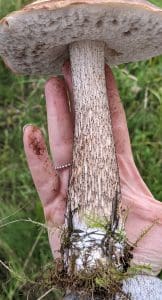
Underside (fertile)
This is a polypore fungi- 100’s of Pores (tiny holes) on the underside of the cap which are off white in colour, they do not rapidly undergo colour change when bruised but will slowly go slightly browner as they will also with age. The pores (visible) are the end of tubes, which you can see if you cut a cross section of the cap. A feature of all boletes is that you can gently peel the pore layer away from the cap. The pore attachment is adnexed, they dip towards cap at the stem.
Sometimes the pore can be seen hanging down past the cap.
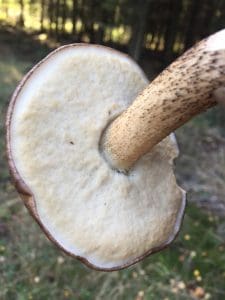
Smell:
Pleasant mushroom scent
Spores:
Olivaceous brown
Known hazards
Do not eat raw, must be cooked.
Potential lookalikes
No toxic look-a-likes
The Orange birch Bolete which as the name suggests also likes to grow with birch is very similar but with a brighter orange-brown coloured cap and can be slightly larger. The cap overhanging the pores is a feature that only the Orange Birch Bolete has so is a good identifier. A great edible but has to be well cooked, if undercooked it can be mildly toxic.
Leccinum cyanobasileucum is very similar and grows with birch as well, but has blue coloration in the base of the stem when cut in half. Another good edible.
All Leccinum are edible, just the orange birch bolete needs to be well cooked.
Uses:
In food
It has a passable flavour and texture that work best as a filler with other mushrooms.
They dry well so they can be used re hydrated in stews or my favourite is powdered to make mushroom sauces, this is also the best way to treatment older specimens.
Boletes unless young and firm can have a tendency to have a bit of a soggy texture if cooked in wet dishes. Cooking them in a little butter until the juices have fried off keeps the texture firmer and tender.
Best when young but If you have a mushroom which is older but still good, you may want to discard the pore and tube layer which peels away very easily, as the pores in particular can be soggy when older.. Don’t bin them though! You can either peel them off and leave them in the woods or dry them for mushroom powder.
Boletes are fairly susceptible to burrowing grubs which are of no harm but everyone has their acceptable ratio. I cut a little slice of the stem and cap to make sure they are not full of them past being usable. If they are better to leave them in the woodland for insects and animals to eat.
Can be used to make up the number of Ceps in a recipe.



